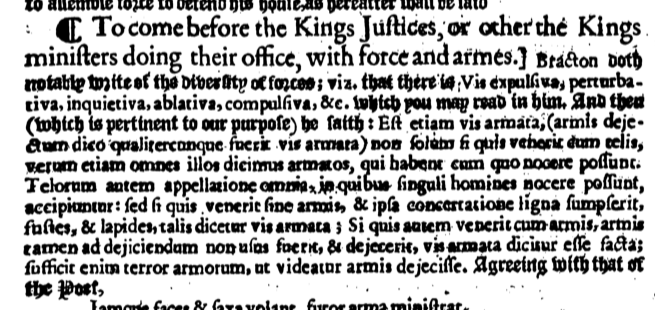Duke Center for Firearms Law By Jonah Skolnik on September 17, 2021
Observations Regarding the Interpretation and Legacy of the Statute of Northampton in Anglo-American Legal History
The Statute of Northampton of 1328 remains central to the current debate surrounding the limits and protections the Second Amendment provides to carry arms in public.[1] The Statute provided that “no man great nor small, of what condition soever he be, except the king’s servants in his presence…come before the King’s justices, or other of the King’s ministers doing their office, with force and arms, nor bring no force in affray of the peace, nor to go nor ride armed by night nor by day, in fairs, markets, nor in the presence of the justices or other ministers” (2 Edw. 3, c.3). Certain Second Amendment scholars hold that the Statute was “not interpreted literally” and was only enforced when weapons were carried with the intent to terrify or threaten or when dangerous and unusual weapons were carried.[2] While the Statute has been much studied, some key sources remain neglected, namely the reliance of Sir. Edward Coke on 13th Century English legal scholar Henry de Bracton in Coke’s interpretation of the Statute. Coke’s quotations from de Bracton, which have usually been ignored because they are written almost entirely in Latin, offer additional evidence that the Statute of Northampton was understood to be a broad-based prohibition on the carrying of arms.
As one of the most respected and celebrated jurists of the Elizabethan and Jacobean eras, Edward Coke’s interpretation of laws has remained influential in the understanding of both British and American constitutional law. In his Institutes of the Lawes of England, written between 1628 to 1644 as a series of legal treatises, Coke offers his understanding of a wide variety of legal issues that bear relevance to contemporary law, including the definition of monopolies and regulation of abortion. Coke also provides an analysis of the Statute of Northampton. In his explanation of the prohibition on coming before royal officials with “force and armes,” he refers to the interpretation of different types of forces by the 13th-century jurist Henry de Bracton, citing vis armata, or armed force as “pertinent to our people,” and therefore relevant to the interpretation of the statute. Coke goes on to cite verbatim Volume 3, p.20 of de Bracton’s On the Laws and Customs of England, which describes the various types of forces (in Latin, vis) and what constitutes these forces. De Bracton particularly focuses on what constitutes “vis armata [armed force].” A text and translation of Coke’s interpretation of the Statute of Northampton and his interpolation of de Bracton are provided below:

“[To come before the Kings Justices, or other the Kings ministers doing their office with force and armes.] Bracton doth notably write of the diversity of forces; viz; that is to say expulsive force, pertaining to pertnbativa [force], pertaining to disquieting [force], ablative force, compulsive force and others, which you may read in him. And then (which is pertinent to our people) he saith: There is also armed force ([one] is deprived of arms, I say, if there was armed force of any kind) not only if one comes with weapons, but truly also we designate those armed, who have something with which they are able to harm. All things by which individual people are able to harm are accepted by the name of weapons: but if someone should come without arms and in a brawl itself pick up wood, sticks and stones, such things it is said armed force; If someone comes with arms, but puts them down without using them, armed force is said to have happened; Even the threat of arms suffices as it seems to be force with arms. Agreeing with that of the poet, ‘And now fire and rocks fly, fury provides weapons’”
More:
https://firearmslaw.duke.edu/2021/09/observations-regarding-the-interpretation-and-legacy-of-the-statute-of-northampton-in-anglo-american-legal-history/